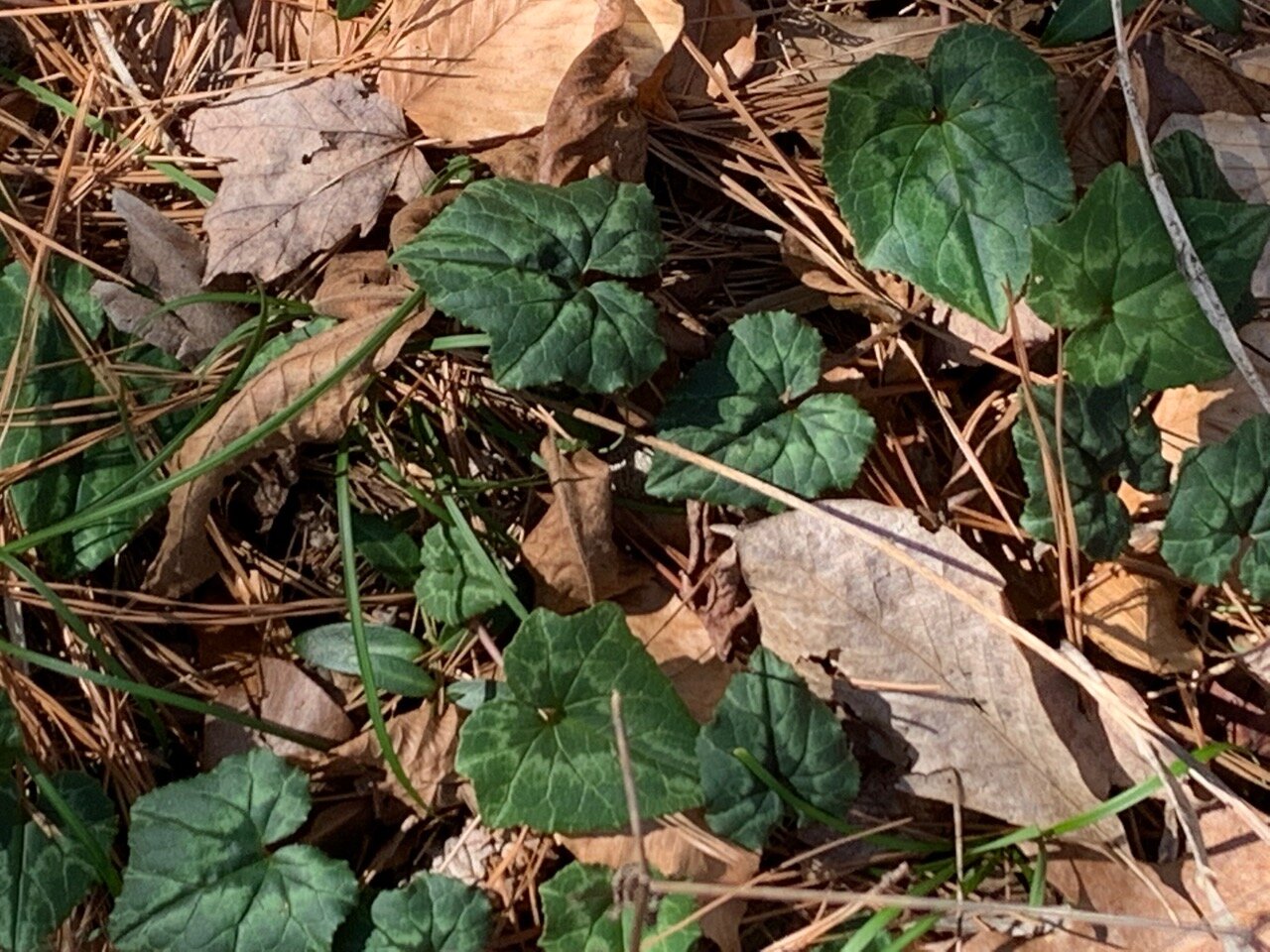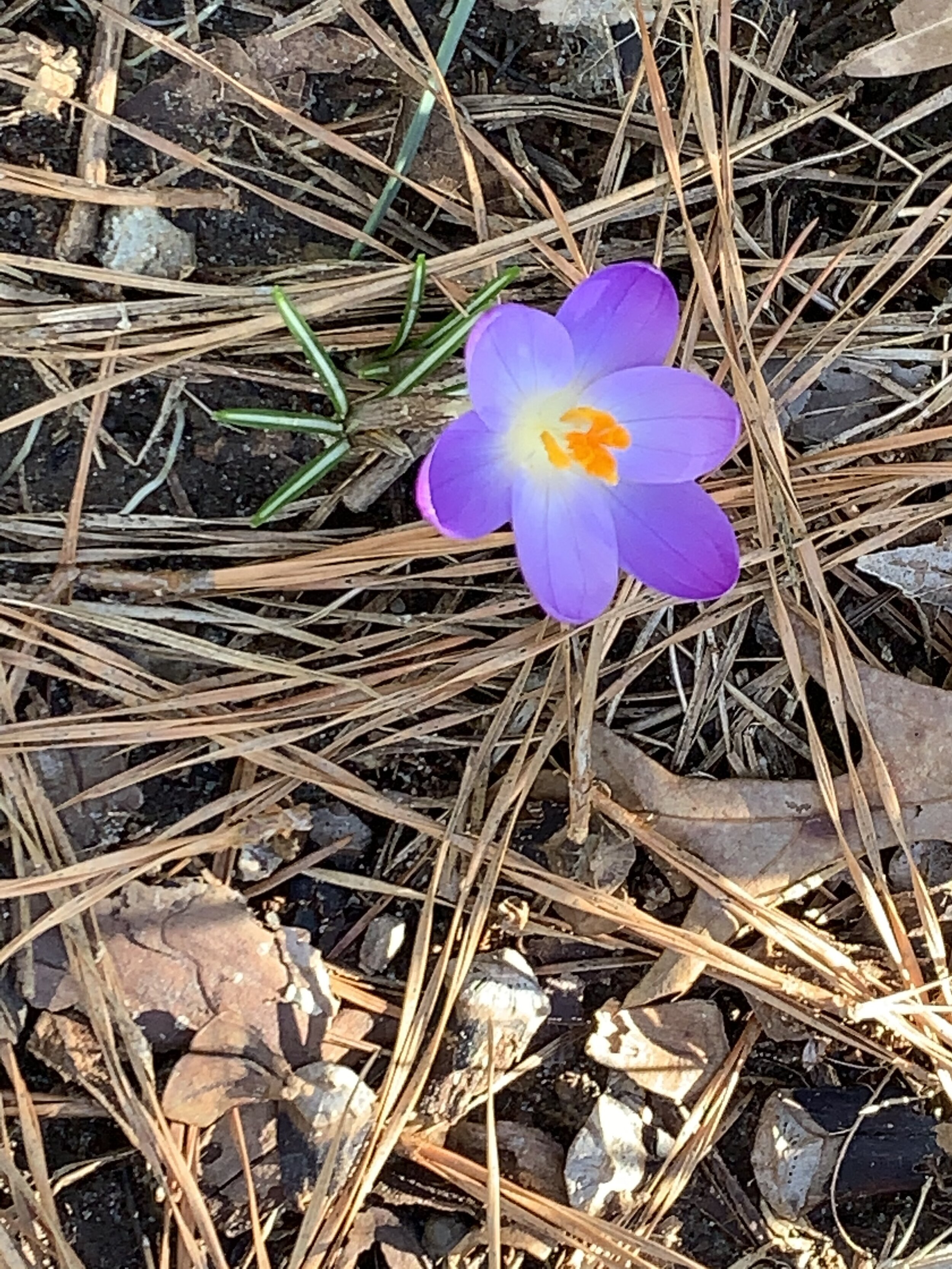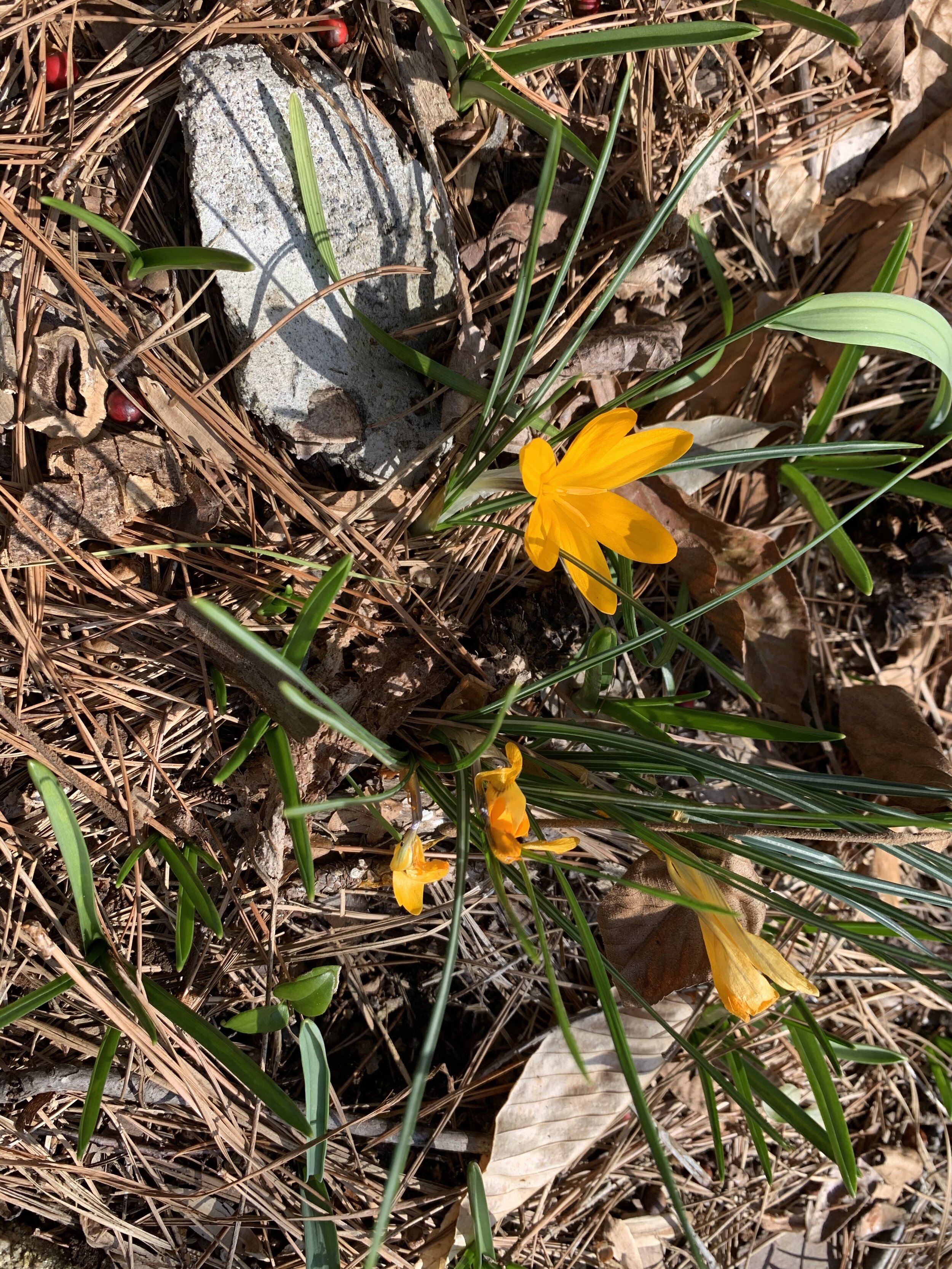The Joslin Garden Wildflower Circle
There is a planting bed Mary Coker Joslin called the Wildflower Circle in the driveway circle center. Indeed, the circle bed is packed with the littlest bulbs to the showiest wildflowers. As the season progresses, we will learn more about what’s flowering in the Wildflower Circle, but for today, let’s MARCH FOURTH and learn about three bulbs making a show of it today!
Not all “bulbs” are the same. There are five bulb types falling under that title: true bulbs, corms, tubers, rhizomes, and tuberous roots. It’s a good idea to understand differences, but it’s also OK to call them all bulbs. Or at least I think so.
True bulbs contain a fully formed plant. Daffodils, tulips, lilies, grape hyacinths, and amaryllis are all true bulbs. If you slice open a daffodil vertically, you will find the entire embryonic daffodil—flower, stem, leaves, and roots—ready to spring forth once the time is right.
Corms are similar to true bulbs in that they contain a stem base, but they do not hold the entire embryo plant. The roots growing from a basal plate are located on the bottom of the corm. (The basal plate is the base area of the bulb.) The growth point is located on the top of the corm. A corm only lasts for a single season, but a new corm will form on top of the old. Plus, “cormels” are also produced, forming around the corm’s basal plate base. Popular corms include gladiolus and crocus.
Tubers have an underground stem base with no basal plate. The tuber's roots grow from both the base and from the sides, with multiple growth points spread out over the tuber’s surface. Classic examples are anemone and caladiums.
A rhizome is a thickened stem that grows either partly or completely underground. If you immediately thought of a bearded iris, you are correct. On a rhizome, the largest growth point is located at one end, with additional growth points located along the sides. Most of us can clearly identify these bulbs as rhizomes.
Tuberous roots are the fifth and final type of bulb. Most often, tuberous roots are not thought of as bulbs at all (at least, not by me), but they are. Their parts below the ground are unmistakable. Unlike other bulb types, those tuberous roots have puffy root-like structures that look as though someone pumped them up like a balloon, but they are really adapted stems—not a true root. Instead, the actual root grows from the sides and the tip of the tuberous root. Familiar tuberous root plants include dahlias and daylilies.
If you want to read a charming book by Elizabeth Lawrence, check out her 1950s title called: The Little Bulbs, A Tale of Two Gardens. Of course, we aim to charm, too, so please read on!
When styling your garden at home, there is no reason not to have bulbs blooming during every month of the year. The variety is astounding. I had so many summer-blooming bulbs, but I never actually thought of them as bulbs. In the end, I don’t suppose it mattered, as long as I enjoyed watching the hummingbird sipping nectar from cannas, wondered at the twisting red and yellow petals of the glory lily (Gloriosa superba), or admired the crocosmia lying across the gravel path.
THE WILDFLOWER CIRCLE
GALANTHUS spp., Snowdrops
Snowdrop, Galanthus spp. are herbaceous plants of the Amaryllis family, a genus of perennial grasses. In nature, there are about 20 species, most native to the Caucasus and Asia.
Biologists cannot say for sure how many Galanthus species since are several opinions on this matter. However, they all believe that the number of plant varieties exceeds 18. Many types of snowdrops are very similar to each other, and most are approximately the same size.
Did you know all plants receive their names—genus, specific epithet, cultivar—either from the place found or in honor of the people who discovered and researched them. Often, as we will see with G. Nivalis, the genus and species we named from a Greek (genus) and Latin (species) word.
Within the Wildflower Circle, I’ve found (so far) two species of Galanthus—G. nivalis and G. elwesi.
Snowdrops are a true harbinger of spring, or should I say winter, since they typically bloom from January to mid-March? Forming an impressive blanket of white in areas where they’re native or have naturalized, like in The Joslin Garden.
GALANTHUS NIVALIS
Galanthus nivalis, considered the common snowdrop, is the best-known and most widespread of the 18 or more species in its genus, Galanthus.
Galanthus nivalis earned its name from the combination of two words, one Greek and the other Latin. Galanthus, from the ancient Greek word, means “milk-white flower,” while the Latin word nivalis means resembling snow.
Easily grown in average, medium moisture, well-drained soils in full sun to part shade. Prefers moist, humusy soils in part shade. Grows particularly well under deciduous trees where exposure to the sun is full in early spring, but gradually changes to part shade as the trees leaf out.
GALANTHUS ELWESI
Galanthus elwesi, Large snowdrops
Galanthus elwesi is commonly referred to as the large or giant snowdrop. G. elwesi has larger flowers, leaves, and size than the similar common snowdrop, G. nivalis. Each flower has six tepals—three spreading outer tepals and three shorter inner tepals.
These large snowdrops favor the same growing conditions as G. nivalis.
Specific epithet honors Henry John Elwes (1846-1922), an English entomologist, botanist, and naturalist who is believed to have introduced the plant into cultivation. Species plants are native to mountain areas of western Turkey.
CYCLAMEN COUM
The Joslin Garden has an existing, albeit out of date, a database of plants. There are three Cyclamen spp. listed—Cyclamen coum, C. hederifolium, and C. var album. So far, I’ve identified two, one in bloom, and the other waiting to emerge. Again, special thanks to Tim Alderton, at the JC Raulston Arboretum for identifying the two found so far.
These guys are so similar I couldn’t tell the difference, until Tim’s identification. To tell the difference, look to the flowers. Cyclamen coum flowers are dumpy and have no auricles at the base. The flowers of C. hederifolium are more elongated and have auricles. The leaves are also different, and for now, since C. hederifolium isn’t in bloom at this time, you can also look to the foliage. C. coum has rounded leaves, and C. hederifolium is more pointed. And of course, you can just enjoy the bloom and now worry at all about identifying the various ones.
Cyclamen coum
CYCLAMEN HEDERIFOLIUM
Cyclamen hederifolium
CROCUS
The Joslin Garden plant list for 2007 indicates two croci (plural for crocus), a blue form, and a yellow form. The cultivar isn’t listed. Both are blooming now.
This crocus is identified as a purple form in the 2007 database. I can name this one, it is Crocus tommasinianus or affectionally know as the Tommies
Yellow form crocus.
Gardeners often confuse crocus with colchicum. I tend to think of crocus as a spring-blooming bulb and colchicum blooming in the fall. Except for Crocus satvius, also known as the saffron crocus blooming in the fall.
Telling the difference between crocus and colchicum is easy once you know two main traits to look for.
One. Flowers: Colchicum flowers have six stamen (male flower part), while croci have only three.
Two. Foliage: Spring-blooming crocus varieties flower at the same time foliage emerges. So if you see foliage AND flowers, it is one of the spring crocus varieties, not so with Colchicum. spp. With colchicum, the flowers bloom without foliage, which comes later. Some refer to as nakked ladies. (I wonder what Mary Coker Joslin thought about that? I know it makes me blush.) Colchicum leaves appear in spring and is large and floppy, then the flower follows in the fall.
Thanks for following us along on The Joslin Garden journey!
Until soon,
Helen Yoest
Horticulturist Specialist
Environmental Scientist, M.S.







